TiO2-Photocatalyzed Water Depollution, a Strong, yet Selective Depollution Method: New Evidence from the Solar Light Induced Degradation of Glucocorticoids in Freshwaters
Abstract
1. Introduction
2. Materials and Methods
2.1. Reagents and Materials
2.2. Analytical Determination
2.3. Irradiation Experiments
3. Results and Discussion
3.1. Kinetic Degradation in Actual Samples
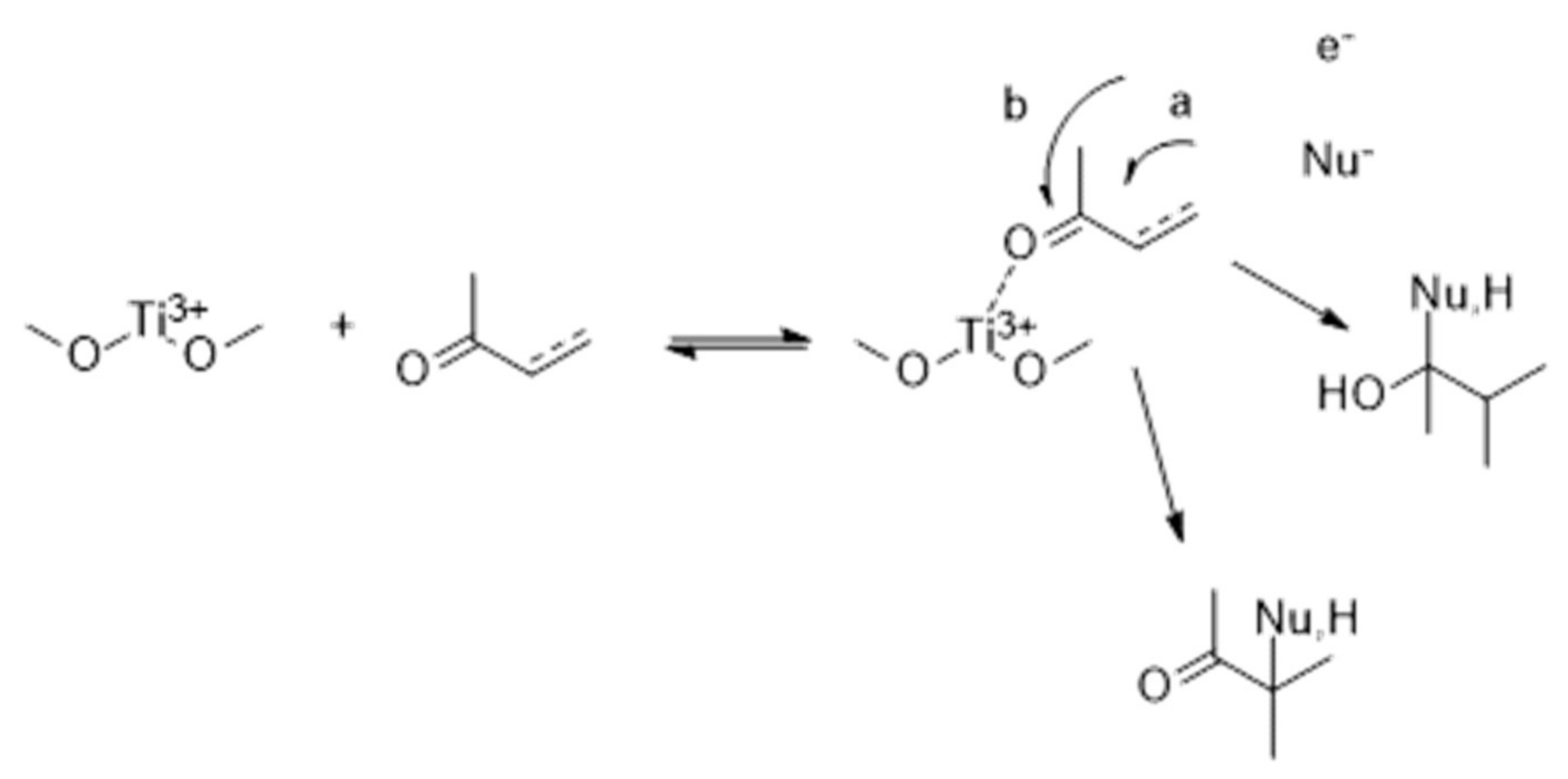
3.2. Matrix Effects: Salts and Humic Acids
3.3. Identification of Photoproducts
4. Conclusions
Supplementary Materials
Author Contributions
Funding
Institutional Review Board Statement
Informed Consent Statement
Data Availability Statement
Conflicts of Interest
References
- Ramamoorthy, S.; Cidlowski, J.A. Corticosteroids. Rheum. Dis. Clin. N. Am. 2016, 42, 15–31. [Google Scholar] [CrossRef] [PubMed]
- Oakley, R.H.; Cidlowski, J.A. The biology of the glucocorticoid receptor: New signaling mechanisms in health and disease. J. Allergy Clin. Immunol. 2013, 132, 1033–1044. [Google Scholar] [CrossRef] [PubMed]
- Bolster, M.B. Corticosteroids: Friends and Foes. Rheum. Dis. Clin. N. Am. 2016, 42, xv–xvi. [Google Scholar] [CrossRef] [PubMed]
- Jia, A.; Wu, S.; Daniels, K.D.; Snyder, S.A. Balancing the Budget: Accounting for Glucocorticoid Bioactivity and Fate during Water Treatment. Environ. Sci. Technol. 2016, 50, 2870–2880. [Google Scholar] [CrossRef]
- Duclos, M. Glucocorticoids: A Doping Agent? Endocrinol. Metab. Clin. N. Am. 2010, 39, 107–126. [Google Scholar] [CrossRef]
- EEC council directive No. 96/22/EC. Off. J. Eur. Commun. L 1996, 125. Available online: https://eur-lex.europa.eu/legal-content/EN/ALL/?uri=CELEX%3A31996L0023 (accessed on 14 February 2021).
- Weizel, A.; Schlüsener, M.P.; Dierkes, G.; Wick, A.; Ternes, T.A. Analysis of the aerobic biodegradation of glucocorticoids: Elucidation of the kinetics and transformation reactions. Water Res. 2020, 174, 115561. [Google Scholar] [CrossRef] [PubMed]
- Kugathas, S.; Williams, R.J.; Sumpter, J.P. Prediction of environmental concentrations of glucocorticoids: The River Thames, UK, as an example. Environ. Int. 2012, 40, 15–23. [Google Scholar] [CrossRef]
- Herrero, P.; Borrull, F.; Pocurull, E.; Marcé, R.M. Determination of glucocorticoids in sewage and river waters by ultra-high performance liquid chromatography–tandem mass spectrometry. J. Chromatogr. A 2012, 1224, 19–26. [Google Scholar] [CrossRef]
- Weizel, A.; Schlüsener, M.P.; Dierkes, G.; Ternes, T.A. Occurrence of Glucocorticoids, Mineralocorticoids, and Progestogens in Various Treated Wastewater, Rivers, and Streams. Environ. Sci. Technol. 2018, 52, 5296–5307. [Google Scholar] [CrossRef]
- Speltini, A.; Merlo, F.; Maraschi, F.; Sturini, M.; Contini, M.; Calisi, N.; Profumo, A. Thermally condensed humic acids onto silica as SPE for effective enrichment of glucocorticoids from environmental waters followed by HPLC-HESI-MS/MS. J. Chromatogr. A 2018, 1540, 38–46. [Google Scholar] [CrossRef]
- Wu, S.; Jia, A.; Daniels, K.D.; Park, M.; Snyder, S.A. Trace analysis of corticosteroids (CSs) in environmental waters by liquid chromatography–tandem mass spectrometry. Talanta 2019, 195, 830–840. [Google Scholar] [CrossRef]
- Fan, Z.; Wu, S.; Chang, H.; Hu, J. Behaviors of Glucocorticoids, Androgens and Progestogens in a Municipal Sewage Treatment Plant: Comparison to Estrogens. Environ. Sci. Technol. 2011, 45, 2725–2733. [Google Scholar] [CrossRef] [PubMed]
- Chang, H.; Hu, J.; Shao, B. Occurrence of Natural and Synthetic Glucocorticoids in Sewage Treatment Plants and Receiving River Waters. Environ. Sci. Technol. 2007, 41, 3462–3468. [Google Scholar] [CrossRef] [PubMed]
- Shen, X.; Chang, H.; Sun, Y.; Wan, Y. Determination and occurrence of natural and synthetic glucocorticoids in surface waters. Environ. Int. 2020, 134, 105278. [Google Scholar] [CrossRef]
- Gong, J.; Lin, C.; Xiong, X.; Chen, D.; Chen, Y.; Zhou, Y.; Wu, C.; Du, Y. Occurrence, distribution, and potential risks of environmental corticosteroids in surface waters from the Pearl River Delta, South China. Environ. Pollut. 2019, 251, 102–109. [Google Scholar] [CrossRef] [PubMed]
- Schriks, M.; van Leerdam, J.A.; van der Linden, S.C.; van der Burg, B.; van Wezel, A.P.; de Voogt, P. High-Resolution Mass Spectrometric Identification and Quantification of Glucocorticoid Compounds in Various Wastewaters in The Netherlands. Environ. Sci. Technol. 2010, 44, 4766–4774. [Google Scholar] [CrossRef] [PubMed]
- Guedes-Alonso, R.; Santana-Viera, S.; Montesdeoca-Esponda, S.; Afonso-Olivares, C.; Sosa-Ferrera, Z.; Santana-Rodríguez, J.J. Application of microwave-assisted extraction and ultra-high performance liquid chromatography–tandem mass spectrometry for the analysis of sex hormones and corticosteroids in sewage sludge samples. Anal. Bioanal. Chem. 2016, 408, 6833–6844. [Google Scholar] [CrossRef]
- Willi, R.A.; Faltermann, S.; Hettich, T.; Fent, K. Active Glucocorticoids Have a Range of Important Adverse Developmental and Physiological Effects on Developing Zebrafish Embryos. Environ. Sci. Technol. 2018, 52, 877–885. [Google Scholar] [CrossRef] [PubMed]
- Willi, R.A.; Castiglioni, S.; Salgueiro-González, N.; Furia, N.; Mastroianni, S.; Faltermann, S.; Fent, K. Physiological and Transcriptional Effects of Mixtures of Environmental Estrogens, Androgens, Progestins, and Glucocorticoids in Zebrafish. Environ. Sci. Technol. 2020, 54, 1092–1101. [Google Scholar] [CrossRef] [PubMed]
- Xin, N.; Jiang, Y.; Liu, S.; Zhou, Y.; Cheng, Y. Effects of prednisolone on behavior and hypothalamic–pituitary–interrenal axis activity in zebrafish. Environ. Toxicol. Pharmacol. 2020, 75, 103325. [Google Scholar] [CrossRef]
- Willi, R.A.; Salgueiro-González, N.; Carcaiso, G.; Fent, K. Glucocorticoid mixtures of fluticasone propionate, triamcinolone acetonide and clobetasol propionate induce additive effects in zebrafish embryos. J. Hazard. Mater. 2019, 374, 101–109. [Google Scholar] [CrossRef] [PubMed]
- Cantalupi, A.; Maraschi, F.; Pretali, L.; Albini, A.; Nicolis, S.; Ferri, E.N.; Profumo, A.; Speltini, A.; Sturini, M. Glucocorticoids in freshwaters: Degradation by solar light and environmental toxicity of the photoproducts. Int. J. Environ. Res. Public Health 2020, 17, 8717. [Google Scholar] [CrossRef] [PubMed]
- Gmurek, M.; Olak-Kucharczyk, M.; Ledakowicz, S. Photochemical decomposition of endocrine disrupting compounds – A review. Chem. Eng. J. 2017, 310, 437–456. [Google Scholar] [CrossRef]
- Serpone, N.; Artemev, Y.M.; Ryabchuk, V.K.; Emeline, A.V.; Horikoshi, S. Light-driven advanced oxidation processes in the disposal of emerging pharmaceutical contaminants in aqueous media: A brief review. Curr. Opin. Green Sustain. Chem. 2017, 6, 18–33. [Google Scholar] [CrossRef]
- Pretali, L.; Maraschi, F.; Cantalupi, A.; Albini, A.; Sturini, M. Water Depollution and Photo-Detoxification by Means of TiO2: Fluoroquinolone Antibiotics as a Case Study. Catalysts 2020, 10, 628. [Google Scholar] [CrossRef]
- Calza, P.; Pelizzetti, E.; Brussino, M.; Baiocchi, C. Ion trap tandem mass spectrometry study of dexamethasone transformation products on light activated TiO2 surface. J. Am. Soc. Mass Spectrom. 2001, 12, 1286–1295. [Google Scholar] [CrossRef]
- Romão, J.S.; Hamdy, M.S.; Mul, G.; Baltrusaitis, J. Photocatalytic decomposition of cortisone acetate in aqueous solution. J. Hazard. Mater. 2015, 282, 208–215. [Google Scholar] [CrossRef] [PubMed]
- Klauson, D.; Pilnik-Sudareva, J.; Pronina, N.; Budarnaja, O.; Krichevskaya, M.; Käkinen, A.; Juganson, K.; Preis, S. Aqueous photocatalytic oxidation of prednisolone. Open Chem. 2013, 11, 1620–1633. [Google Scholar] [CrossRef]
- Díez, A.M.; Ribeiro, A.S.; Sanromán, M.A.; Pazos, M. Optimization of photo-Fenton process for the treatment of prednisolone. Environ. Sci. Pollut. Res. 2018, 25, 27768–27782. [Google Scholar] [CrossRef] [PubMed]
- Yin, K.; He, Q.; Liu, C.; Deng, Y.; Wei, Y.; Chen, S.; Liu, T.; Luo, S. Prednisolone degradation by UV/chlorine process: Influence factors, transformation products and mechanism. Chemosphere 2018, 212, 56–66. [Google Scholar] [CrossRef]
- He, X.; Huang, H.; Tang, Y.; Guo, L. Kinetics and mechanistic study on degradation of prednisone acetate by ozone. J. Environ. Sci. Health Part A 2020, 55, 292–304. [Google Scholar] [CrossRef] [PubMed]
- Welter, J.B.; da Silva, S.W.; Schneider, D.E.; Rodrigues, M.A.S.; Ferreira, J.Z. Performance of Nb/BDD material for the electrochemical advanced oxidation of prednisone in different water matrix. Chemosphere 2020, 248, 126062. [Google Scholar] [CrossRef] [PubMed]
- Ghenaatgar, A.; Tehrani, R.M.A.; Khadir, A. Photocatalytic degradation and mineralization of dexamethasone using WO3 and ZrO2 nanoparticles: Optimization of operational parameters and kinetic studies. J. Water Process Eng. 2019, 32, 100969. [Google Scholar] [CrossRef]
- Guo, Z.; Guo, A.; Guo, Q.; Rui, M.; Zhao, Y.; Zhang, H.; Zhu, S. Decomposition of dexamethasone by gamma irradiation: Kinetics, degradation mechanisms and impact on algae growth. Chem. Eng. J. 2017, 307, 722–728. [Google Scholar] [CrossRef]
- Giahi, M.; Taghavi, H.; Habibi, S. Photocatalytic degradation of betamethasone sodium phosphate in aqueous solution using ZnO nanopowder. Russ. J. Phys. Chem. A 2012, 86, 2003–2007. [Google Scholar] [CrossRef]
- Thomas, A.G.; Syres, K.L. Adsorption of organic molecules on rutile TiO2 and anatase TiO2 single crystal surfaces. Chem. Soc. Rev. 2012, 41, 4207. [Google Scholar] [CrossRef] [PubMed]
- Sushko, M.L.; Gal, A.Y.; Shluger, A.L. Interaction of organic molecules with the TiO2 (110) surface: Ab inito calculations and classical force fields. J. Phys. Chem. B 2006, 110, 4853–4862. [Google Scholar] [CrossRef] [PubMed]
- Sturini, M.; Speltini, A.; Maraschi, F.; Profumo, A.; Pretali, L.; Fasani, E.; Albini, A. Photochemical Degradation of Marbofloxacin and Enrofloxacin in Natural Waters. Environ. Sci. Technol. 2010, 44, 4564–4569. [Google Scholar] [CrossRef] [PubMed]
- Petala, A.; Mantzavinos, D.; Frontistis, Z. Impact of water matrix on the photocatalytic removal of pharmaceuticals by visible light active materials. Curr. Opin. Green Sustain. Chem. 2021, 28, 100445. [Google Scholar] [CrossRef]
- Vione, D. Photochemical reactions in sunlit surface waters: Influence of water parameters, and implications for the phototransformation of xenobiotic compounds. Photochemistry 2016, 44, 348–363. [Google Scholar]
- Rasolevandi, T.; Naseri, S.; Azarpira, H.; Mahvi, A.H. Photo-degradation of dexamethasone phosphate using UV/Iodide process: Kinetics, intermediates, and transformation pathways. J. Mol. Liq. 2019, 295, 111703. [Google Scholar] [CrossRef]
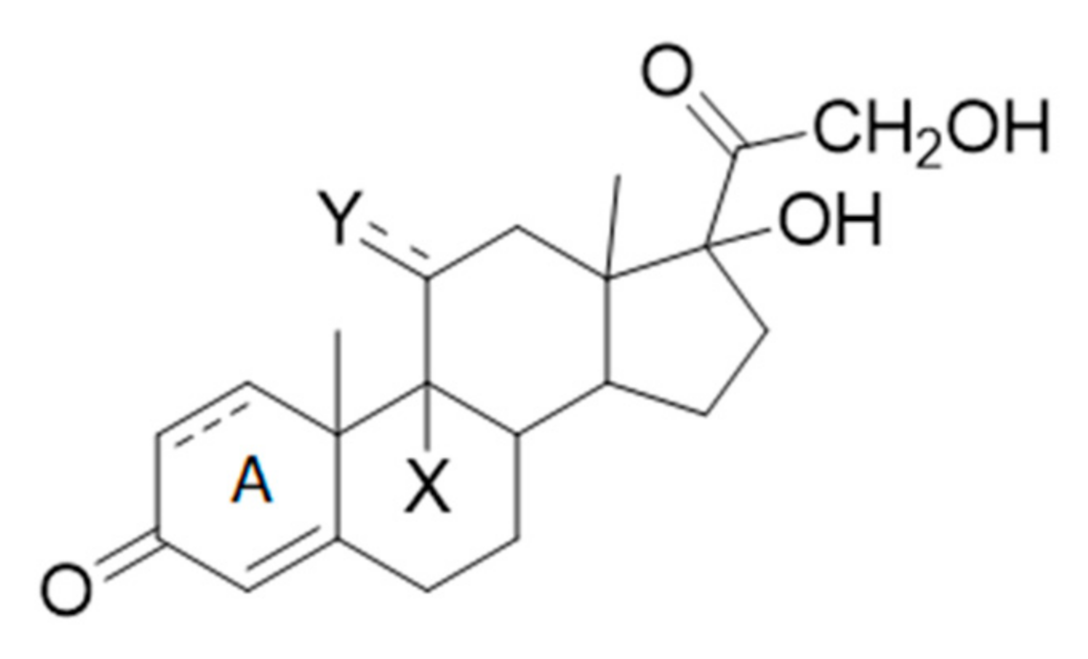
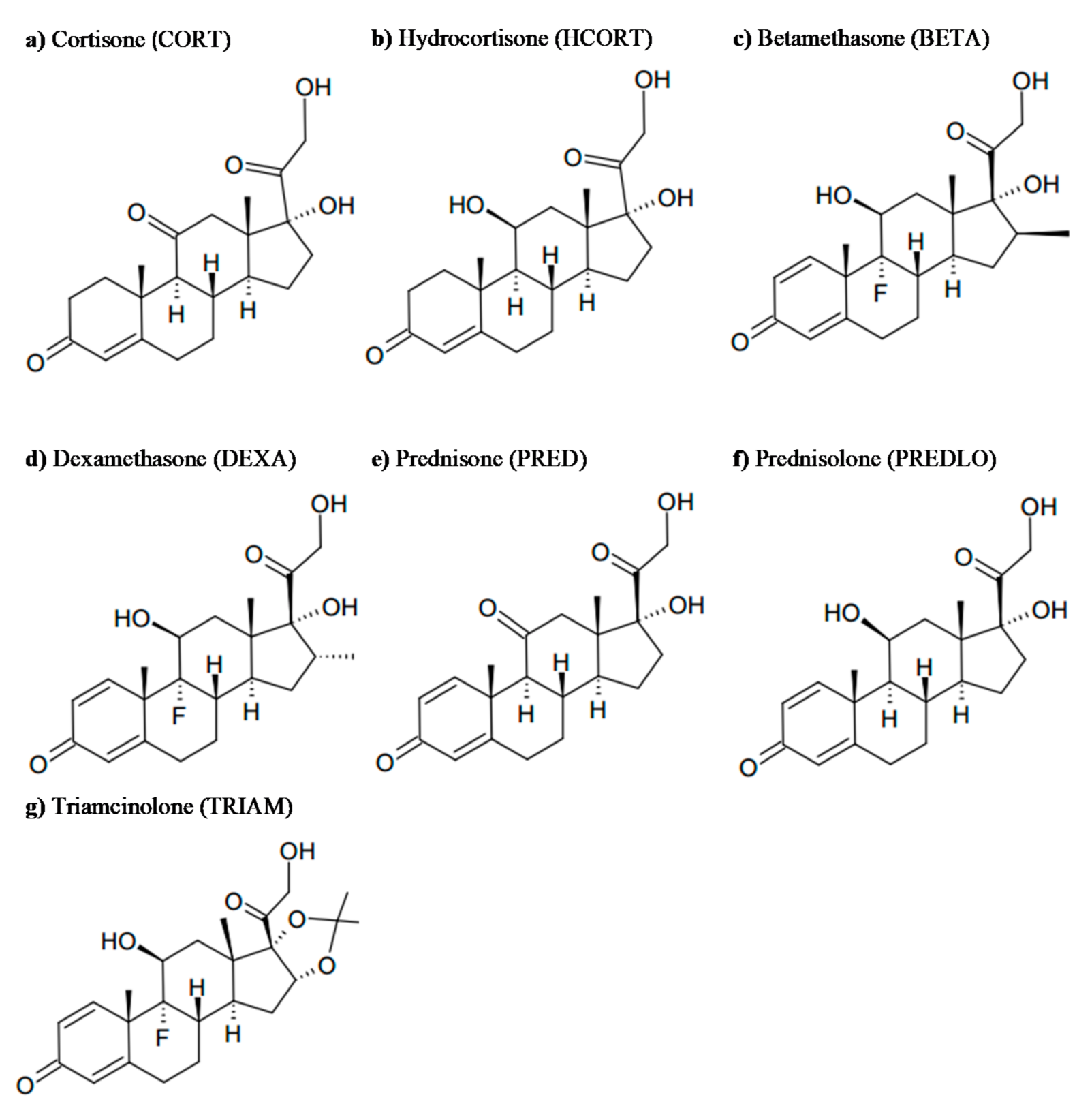
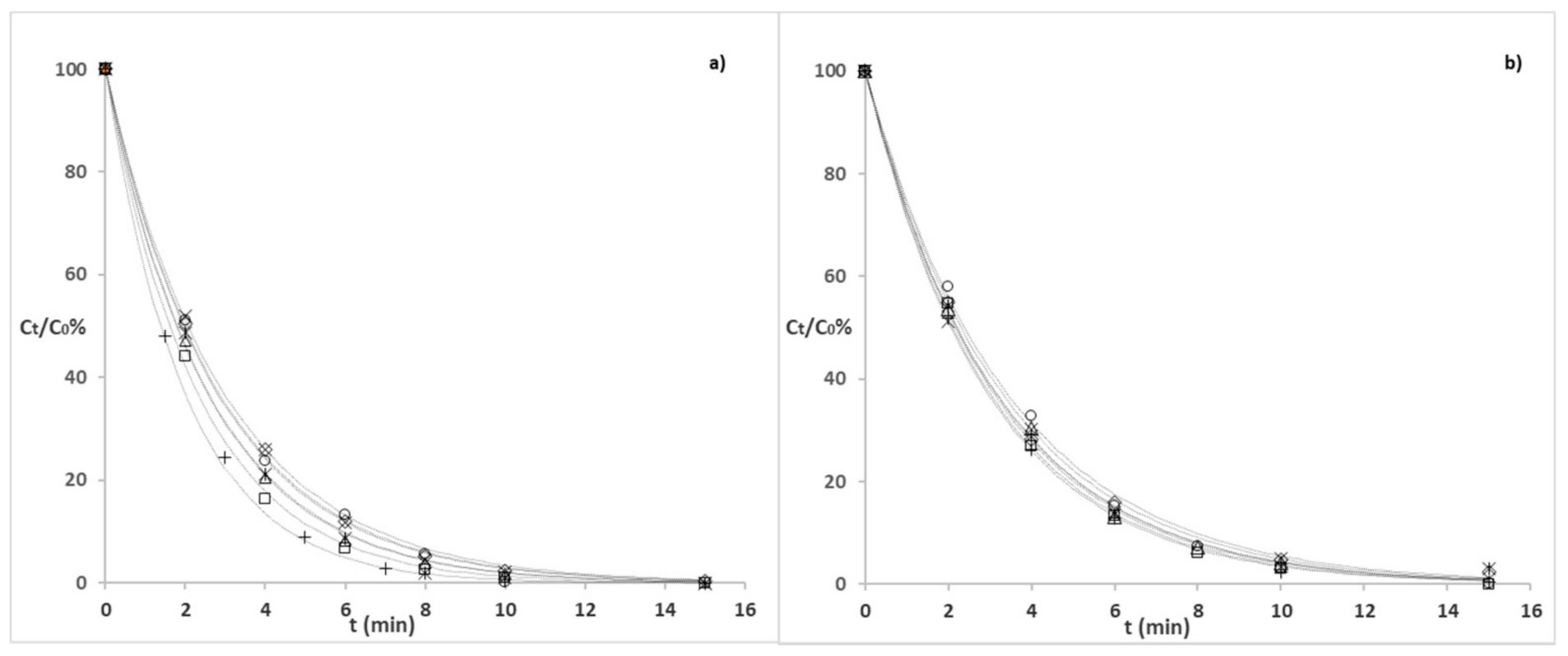
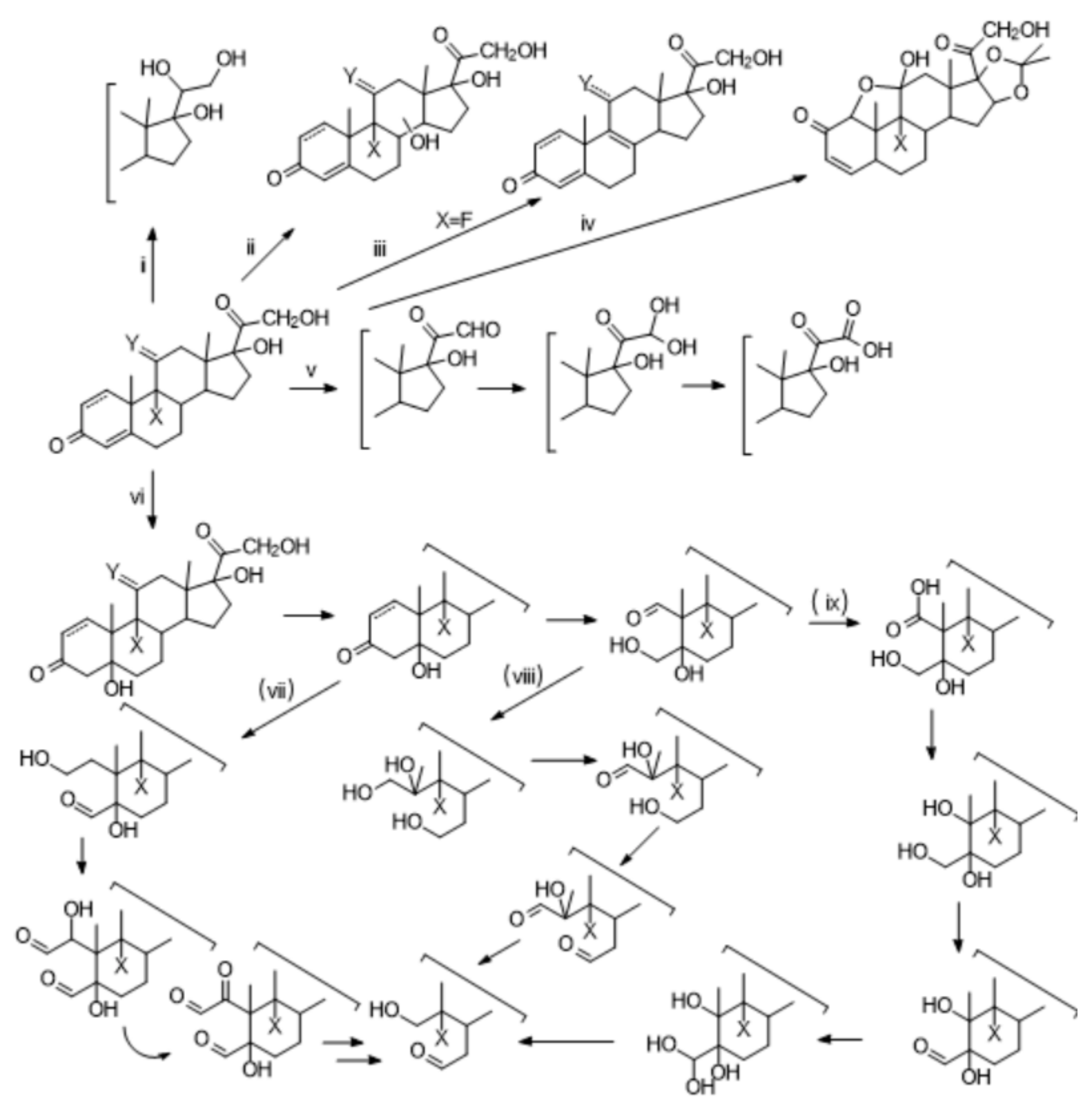
| Parameters/Ions | Tap Water | River Water | |
|---|---|---|---|
| pH | 7.7 | 7.9 | |
| Conductivity at 20 °C | µS cm−1 | 271 | 293 |
| TOC * | mg L−1 | <2 | 6.9 |
| Cl− | mg L−1 | 5.0 | 4.0 |
| NO3− | mg L−1 | 0.6 | 1.5 |
| SO42− | mg L−1 | 5.0 | 13 |
| HCO3− | mg L−1 | 182 | 195 |
| Ca2+ | mg L−1 | 35 | 54 |
| Mg2+ | mg L−1 | 10 | 7.5 |
| Na+ | mg L−1 | 12 | 5.5 |
| Photolysis | Photocatalysis | ||||
|---|---|---|---|---|---|
| Simulated Solar Light | Simulated Solar Light | Natural Sunlight | |||
| Compound | Tap Water kdeg (min−1) | River Water kdeg (min−1) | Tap Water kdeg (min−1) | River Water kdeg (min−1) | River Water kdeg (min−1) |
| CORT | 0.00106(5) | 0.00128(3) | 0.35(3) | 0.300(8) | 0.39(1) |
| HCORT | 0.00246(9) | 0.0033(2) | 0.38(1) | 0.315(8) | 0.38(2) |
| BETA | 0.0115(6) | 0.0114(1) | 0.336(9) | 0.32(1) | 0.35(2) |
| DEXA | 0.0117(1) | 0.0097(6) | 0.386(9) | 0.314(7) | 0.61(1) |
| PRED | 0.0185(9) | 0.0186(6) | 0.431(9) | 0.33(1) | 0.474(9) |
| PREDLO | 0.024(1) | 0.0199(4) | 0.51(1) | 0.336(4) | 0.52(1) |
| TRIAM | 0.0139(3) | 0.0099(4) | 0.355(9) | 0.29(1) | 0.38(1) |
| GC | AOP | Matrix | Kinetic Constant, % Removal, Degradation Time | Ref |
|---|---|---|---|---|
| DEXA 2-50 mg L−1 | Gamma ray, gamma ray with H2O2 or Fenton | Pure water, pH 7.2 | 5 × 10−4 – 4.7 × 10−3 Gy−1 , 8 × 10−4 – 1.6 × 10−3 Gy−1 | [35] |
| PRED 50 mg L−1 | Electrochemical oxidation process 20 mA cm−2 | Pure water, pH 11, Na2SO4 1 g L−1 | 0.1052 mg h−1, 78% removal 4 h | [33] |
| PRED acetate 5 mg L−1 | O3 50 mg min−1 | Pure water, pH 3 | 0.0595 min−1, 90% removal 30 min | [32] |
| PREDLO 3.6 mg L−1 | UV/chlorine, 254 nm | Phosphate buffer pH 7, artificial fresh water pH 6 | 5.53 × 10−3 s−1 | [31] |
| PREDLO 100 mg L−1 | UV-Fenton, 360 nm | Pure water, pH 3 | Quantitative removal 15 min | [30] |
| DEXA 5 mg L−1 | ZrO2 1.5 g L−1, 365 nm WO3 0.5 g L−1, >380 nm | Pure water, pH 3 | ZrO2 0.0078 min−1, 76% removal 180 min WO3 0.0277 min−1, 100% removal 80 min | [34] |
| BETA phosphate 30 mg L−1 | ZnO 0.44 g L−1, 254 nm ZnO 0.44 g L−1, persulfate, 254 nm | Pure water, pH 9 | Removal 63%, 180 min Removal 98%, 180 min | [36] |
| PREDLO 25 mg L−1 | TiO2 P25 1 g L−1, 365 nm or solar light | Pure water, pH 6.7 | Removal 94%, 1 h solar light Removal 73%, 1 h 365 nm | [29] |
| CORT acetate 10 mg L−1 | TiO2 P25, 375 nm, air saturated, TiO2 P25, 375 nm, persulfate air saturated | Different buffer solution, air saturated | 0.040 min−1, quantitative removal 100 min, 0.071 min−1, quantitative removal 30 min | [28] |
| DEXA 10 mg L−1 | TiO2 P25 0.2 g L−1, simulated solar light | Pure water, air saturated | Quantitative removal 15 min | [27] |
| CORT, HCORT, BETA, DEXA, PRED, PREDLO, TRIAM 10 mg L−1 | TiO2 P25 0.5 g L−1, simulated solar light | Tap water, natural pH | 0.184(5), 0.230(7), 0.19(1), 0.206(5), 0.177(7), 0.224(3), 0.24(1) min−1 Removal >95% 15 min | [This work] |
| Compound | CORT | PREDLO | TRIAM |
|---|---|---|---|
| Matrix | kdeg (min−1) | ||
| tw | 0.35 (3) | 0.51 (1) | 0.355 (9) |
| tw + SO42− (50 mg L−1) | 0.41 (3) | 0.539 (5) | 0.31 (1) |
| tw + NO3− (20 mg L−1) | 0.28 (1) | 0.45 (1) | 0.37 (1) |
| tw + HAs (10 mg L−1) | 0.10 (1) | 0.10 (1) | 0.08 (1) |
Publisher’s Note: MDPI stays neutral with regard to jurisdictional claims in published maps and institutional affiliations. |
© 2021 by the authors. Licensee MDPI, Basel, Switzerland. This article is an open access article distributed under the terms and conditions of the Creative Commons Attribution (CC BY) license (http://creativecommons.org/licenses/by/4.0/).
Share and Cite
Pretali, L.; Albini, A.; Cantalupi, A.; Maraschi, F.; Nicolis, S.; Sturini, M. TiO2-Photocatalyzed Water Depollution, a Strong, yet Selective Depollution Method: New Evidence from the Solar Light Induced Degradation of Glucocorticoids in Freshwaters. Appl. Sci. 2021, 11, 2486. https://doi.org/10.3390/app11062486
Pretali L, Albini A, Cantalupi A, Maraschi F, Nicolis S, Sturini M. TiO2-Photocatalyzed Water Depollution, a Strong, yet Selective Depollution Method: New Evidence from the Solar Light Induced Degradation of Glucocorticoids in Freshwaters. Applied Sciences. 2021; 11(6):2486. https://doi.org/10.3390/app11062486
Chicago/Turabian StylePretali, Luca, Angelo Albini, Alice Cantalupi, Federica Maraschi, Stefania Nicolis, and Michela Sturini. 2021. "TiO2-Photocatalyzed Water Depollution, a Strong, yet Selective Depollution Method: New Evidence from the Solar Light Induced Degradation of Glucocorticoids in Freshwaters" Applied Sciences 11, no. 6: 2486. https://doi.org/10.3390/app11062486
APA StylePretali, L., Albini, A., Cantalupi, A., Maraschi, F., Nicolis, S., & Sturini, M. (2021). TiO2-Photocatalyzed Water Depollution, a Strong, yet Selective Depollution Method: New Evidence from the Solar Light Induced Degradation of Glucocorticoids in Freshwaters. Applied Sciences, 11(6), 2486. https://doi.org/10.3390/app11062486







